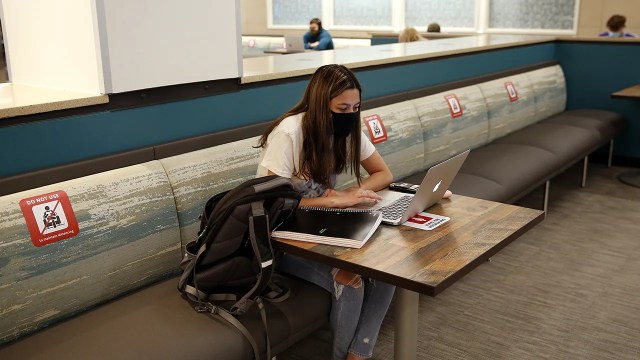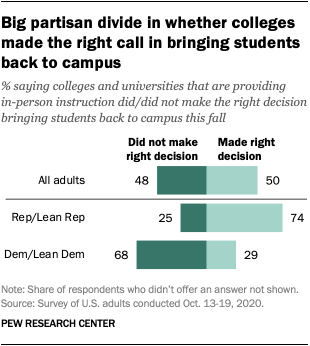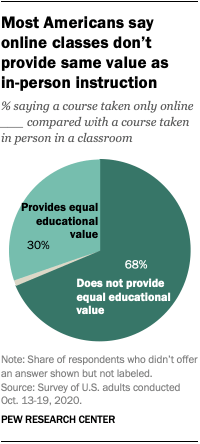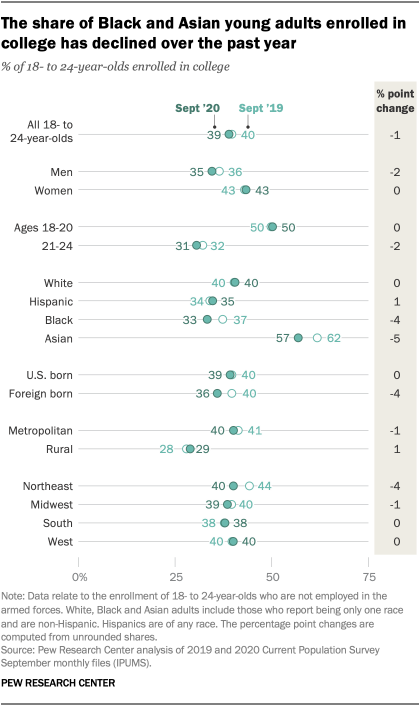
Colleges and universities across the United States scrambled this fall to come up with a safe and practical approach to learning as the coronavirus outbreak showed no signs of easing up, with some schools opting to resume campus life and others going completely virtual.
Colleges are continuing to adapt amid new outbreaks in certain COVID-19 hotspots. Against this backdrop, the public has mixed views on whether providing in-person instruction this fall was a good idea. Half of all U.S. adults say colleges and universities that brought students back to campus made the right decision, while 48% say they did not, according to a new Pew Research Center survey. A separate analysis of Census Bureau data shows that college enrollment among 18- to 24-year-olds dipped only slightly from last year.
Views on whether colleges and universities made the right decision in bringing students back to campus are deeply divided along party lines, with Republicans and those who lean to the Republican Party more than twice as likely as Democrats and Democratic leaners to say bringing students back was the right decision.
This post explores the challenges faced by colleges and universities in the time of COVID-19, including views on whether these institutions should have reopened or not, views on the effectiveness of online learning and trends in student enrollment. The public opinion findings in this report come from a survey fielded Oct. 13-19, 2020, among 10,332 U.S. adults.
Everyone who took part is a member of Pew Research Center’s American Trends Panel (ATP), an online survey panel that is recruited through national, random sampling of residential addresses. This way nearly all U.S. adults have a chance of selection. The survey is weighted to be representative of the U.S. adult population by gender, race, ethnicity, partisan affiliation, education and other categories. Read more about the ATP’s methodology.
Here are the questions used for this report, along with responses, and its methodology.
The analysis of recent college enrollment levels and rates is based on the monthly Current Population Survey (CPS), conducted by the U.S. Census Bureau for the Bureau of Labor Statistics. The CPS is the nation’s premier labor force survey and is the basis for the monthly national unemployment rate released on the first Friday of each month. The CPS is based on a sample survey of about 60,000 households. The estimates are not seasonally adjusted.
Each month the basic CPS questionnaire includes a limited number of questions on school and college enrollment. College enrollment rates tend to exhibit significant seasonal fluctuations. For example, enrollment in the summer months is below the winter and fall months. September 2020 is the most recent data available. To minimize the impact of monthly fluctuations the entire analysis uses September CPS data.
The CPS microdata files provided by the IPUMS at the University of Minnesota were analyzed. In IPUMS the basic school enrollment questions are consolidated into the variable labeled SCHLCOLL.
The COVID-19 outbreak has affected data collection efforts by the U.S. government in its surveys, especially limiting in-person data collection. This resulted in a 4 percentage point decrease in the response rate for the CPS in September 2020. It is possible that some measures of employment and enrollment and its demographic composition are affected by these changes in data collection.
This partisan gap reflects a divide on the response to the coronavirus more broadly. Previous Pew Research Center surveys found that Republicans and Democrats have differed in their views about the severity of the public health crisis, restrictions on businesses and other public activities and mask wearing. In the current poll, 74% of Republicans say schools that are currently providing in-person instruction made the right decision in bringing students back to campus this fall; only 29% of Democrats say the same.
Even at some schools where students are back on campus, online learning is much more prevalent this year than in previous years. And for many schools, almost all classes are being held virtually. Americans are skeptical that this type of learning provides the same value as in-person instruction. Overall, 30% of adults say a course taken only online provides an equal educational value compared with a course taken in person in a classroom; 68% say it does not. Majorities of Republicans and Democrats express this view, although Democrats are somewhat more likely than Republicans to say online classes provide an equal value (33% vs. 26%).
College graduates are among the most likely to say that online classes do not measure up to in-person ones. Among those with a bachelor’s degree or higher, 75% say online classes do not provide an equal educational value. This compares with 67% among those with some college education and 64% for those with a high school diploma or less.
When asked more broadly about how colleges and universities are doing these days, the public continues to express negative views. About four-in-ten Americans (41%) say the higher education system in the U.S. is generally going in the right direction, while a majority (56%) say it’s going in the wrong direction. This is similar to 2018, when 38% of Americans said higher education was going in the right direction and 61% said it was going in the wrong direction.
The partisan gap on this question remains wide. About half of Democrats (49%) say higher education is going in the right direction, while the same share say it’s going in the wrong direction. In contrast, 66% of Republicans say it’s going in the wrong direction, and only 32% say it’s going in the right direction.
Decline in college enrollment more pronounced among Black and Asian young adults, the foreign born and those living in the Northeast
College students themselves have had to make difficult decisions about whether to return to campus – in person or virtually – this fall. A new Pew Research Center analysis of Census Bureau data shows there has been a slight decline in enrollment compared with fall 2019. This September, 11.2 million 18- to 24-year-olds were enrolled in college, down from 11.5 million the same time last year.
Comparing September’s college enrollment rates from 2019 and 2020 shows that some groups of young adults have experienced bigger declines than others. For example, fewer men ages 18 to 24 are enrolled in college this year than last (36% in 2019 vs. 35% in 2020), while women’s college enrollment rate has remained the same (43%).
The shares of Black and Asian American students enrolled in college have dropped noticeably. In 2019, 62% of Asian adults ages 18 to 24 were enrolled in college; that share stands at 57% now. Enrollment among Black adults in this age group declined similarly, dropping from 37% in 2019 to 33% in 2020. Enrollment for White students stayed the same (40%), while enrollment among Hispanics increased from 34% to 35% in 2020.
The share of foreign-born 18- to 24-year-olds enrolled in college dipped 4 percentage points from 2019 to 2020, while the college enrollment of U.S.-born young adults remained unchanged.
The college enrollment rate for 18- to 24-year-olds living in metropolitan areas slipped from 41% in 2019 to 40% in 2020, while the enrollment rate for rural young adults increased 1 percentage point. Regionally, the Northeast (-4 points) and Midwest (-1 point) both saw enrollment rate declines from 2019 to 2020, while the South and West held steady.
Prior to this year, college enrollment had climbed steadily from 1989 through 2012 and has fluctuated since then. The enrollment decline is driven by a downward trend in the share among 21- to 24-year-olds (down 2 points). The share of 18- to 20-year-olds who are enrolled is unchanged from 2019.
Note: Here are the questions used for this report, along with responses, and its methodology.





